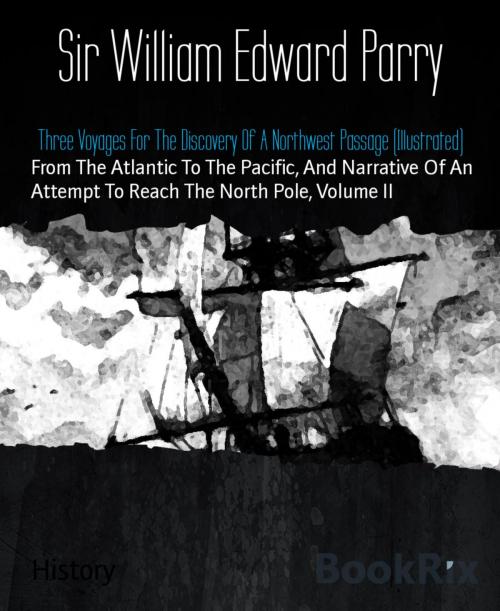Three Voyages For The Discovery Of A Northwest Passage (Illustrated)
From The Atlantic To The Pacific, And Narrative Of An Attempt To Reach The North Pole, Volume II
Nonfiction, History| Author: | Sir William Edward Parry | ISBN: | 9783736803602 |
| Publisher: | BookRix | Publication: | April 25, 2014 |
| Imprint: | Language: | English |
| Author: | Sir William Edward Parry |
| ISBN: | 9783736803602 |
| Publisher: | BookRix |
| Publication: | April 25, 2014 |
| Imprint: | |
| Language: | English |
The Northwest Passage is a sea route connecting the Atlantic and Pacific Oceans through the Arctic Ocean. Interest kindled in 1564 after Jacques Cartier's discovery of the mouth of the Saint Lawrence River, Martin Frobisher had formed a resolution to undertake the challenge of forging a trade route from England westward to India. In 1576 - 1578, he took three trips to what is now the Canadian Arctic in order to find the passage. Frobisher Bay, which he discovered, is named after him. On August 8, 1585, under the employ of Elizabeth I the English explorer John Davis entered Cumberland Sound, Baffin Island. Davis rounded Greenland before dividing his four ships into separate expeditions to search for a passage westward. Though he was unable to pass through the icy Arctic waters, he reported to his sponsors that the passage they sought is "a matter nothing doubtful and secured support for two additional expeditions, reaching as far as Hudson Bay. Though England's efforts were interrupted in 1587 because of Anglo-Spanish War, Davis's favorable reports on the region and its people would inspire explorers in the coming century. In the first half of the 19th century, parts of the Northwest Passage were explored separately by a number of different expeditions, including those by John Ross, William Edward Parry, James Clark Ross; and overland expeditions led by John Franklin, George Back, Peter Warren Dease, Thomas Simpson, and John Rae. Sir Robert McClure was credited with the discovery of the Northwest Passage by sea in 1851 when he looked across McClure Strait from Banks Island and viewed Melville Island. However, the strait was blocked by young ice at this point in the season, and not navigable to ships. The only usable route, linking the entrances of Lancaster Sound and Dolphin and Union Strait was first used by John Rae in 1851. Rae used a pragmatic approach of traveling by land on foot and dogsled, and typically employed less than ten people in his exploration parties. The Northwest Passage was not completely conquered by sea until 1906, when the Norwegian explorer Roald Amundsen, who had sailed just in time to escape creditors seeking to stop the expedition, completed a three-year voyage in the converted 47-ton herring boat Gjøa. At the end of this trip, he walked into the city of Eagle, Alaska, and sent a telegram announcing his success. His route was not commercially practical; in addition to the time taken, some of the waterways were extremely shallow
The Northwest Passage is a sea route connecting the Atlantic and Pacific Oceans through the Arctic Ocean. Interest kindled in 1564 after Jacques Cartier's discovery of the mouth of the Saint Lawrence River, Martin Frobisher had formed a resolution to undertake the challenge of forging a trade route from England westward to India. In 1576 - 1578, he took three trips to what is now the Canadian Arctic in order to find the passage. Frobisher Bay, which he discovered, is named after him. On August 8, 1585, under the employ of Elizabeth I the English explorer John Davis entered Cumberland Sound, Baffin Island. Davis rounded Greenland before dividing his four ships into separate expeditions to search for a passage westward. Though he was unable to pass through the icy Arctic waters, he reported to his sponsors that the passage they sought is "a matter nothing doubtful and secured support for two additional expeditions, reaching as far as Hudson Bay. Though England's efforts were interrupted in 1587 because of Anglo-Spanish War, Davis's favorable reports on the region and its people would inspire explorers in the coming century. In the first half of the 19th century, parts of the Northwest Passage were explored separately by a number of different expeditions, including those by John Ross, William Edward Parry, James Clark Ross; and overland expeditions led by John Franklin, George Back, Peter Warren Dease, Thomas Simpson, and John Rae. Sir Robert McClure was credited with the discovery of the Northwest Passage by sea in 1851 when he looked across McClure Strait from Banks Island and viewed Melville Island. However, the strait was blocked by young ice at this point in the season, and not navigable to ships. The only usable route, linking the entrances of Lancaster Sound and Dolphin and Union Strait was first used by John Rae in 1851. Rae used a pragmatic approach of traveling by land on foot and dogsled, and typically employed less than ten people in his exploration parties. The Northwest Passage was not completely conquered by sea until 1906, when the Norwegian explorer Roald Amundsen, who had sailed just in time to escape creditors seeking to stop the expedition, completed a three-year voyage in the converted 47-ton herring boat Gjøa. At the end of this trip, he walked into the city of Eagle, Alaska, and sent a telegram announcing his success. His route was not commercially practical; in addition to the time taken, some of the waterways were extremely shallow















